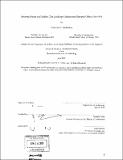Between nature and artifice : The Landscape Architecture Research Office (1966-1979)
Author(s)
McMahon, Catherine F. (Catherine Fae)
DownloadFull printable version (22.47Mb)
Alternative title
Landscape Architecture Research Office (1966-1979)
Other Contributors
Massachusetts Institute of Technology. Dept. of Architecture.
Advisor
Arindam Dutta.
Terms of use
Metadata
Show full item recordAbstract
Cambridge in the 1960s was a locus of experimentation and research in new computing technologies -from the production of transportation models for New England to the design of war games simulating the vagaries of the terrain in Vietnam. One research group, working in the nascent field of computer cartography, was formed in the Department of Landscape Architecture at Harvard University. The Landscape Architecture Research Office (1966-1979) represented a radical departure from existing practices within the discipline. At this time, NASA was making its first moves towards erecting image infrastructures in space-able to beam back streams of pictures describing the earth in seemingly infinite detail. The instrumental extension of man into outer space served to remake an imagination of landscape; and the research office, banking on the promise held out by satellites and computers, was preparing a technological ground to receive this new vision. This thesis will examine two of their early projects, the first a study that utilizes a computer mapping program (GRID), to draw multiple disciplinary objectives, from physical geography to governance to aesthetics, into the same syntactical register-using the map as a technological armature to craft a new theory of landscape. The second project was an experimental studio run by two of LARO's researchers, Carl Steinitz and Peter Rogers, in which they attempt to simulate the function of an imagined computer system able to model all the interconnected processes of urbanization. (cont.) Using maps and students as analogue parts they proceeded to deploy game theory to play-act the computer's operational roles. By doing this, Steinitz and Rogers sought to delimit the role of designer or architect within the mechanisms of a representational system. While the work of LARO was influential in the development of what is known as GIS today, I wish to pull this historical episode out of the technological continuum-looking instead at this moment of profound indeterminacy and speculation over the role that technology could play in the process of design.
Description
Thesis (S.M.)--Massachusetts Institute of Technology, Dept. of Architecture, 2009. Leaf 70 blank. Includes bibliographical references (leaves 68-69).
Date issued
2009Department
Massachusetts Institute of Technology. Department of ArchitecturePublisher
Massachusetts Institute of Technology
Keywords
Architecture.